E series tanks
In May, 1942, Chief Designer of the Tank Armaments Test Division (WaPruf 6), E. Knipkamp created a special research team, which he personally led. This group was to develop a number of projects of combat vehicles, which were supposed to take into account all the combat experience gained in this area in the field of armored vehicles. This work was a personal initiative of the Knip-Kamp, and, naturally, it was rather slow - the main forces of the tank weapon test department were involved in ensuring the mass production of tanks and the development of new designs for the army. However, by April 1943, the group had formulated the basic requirements that should have been translated into new combat vehicles. The whole project received the designation "series E" (E stands for "development", from the German "Entwicklung"). The machines of the E series envisaged the implementation of the following principles:
- to maximize the protection of the frontal part of the body, to strengthen the weapons and mobile ammunition;
- create a single unit for the transmission and ensure its simple assembly and disassembly in the housing to simplify maintenance and repair;
- to increase the internal volume of the hull and reduce the overall height of the machines to use the suspension with the placement of elastic elements outside the hull, as well as to change the layout, placing the engine with the transmission in the stern;
- the design of the suspension should provide the possibility of tensioning the caterpillar when the sloth or part of the rollers is torn to allow the tank to fall to the rear;
- use the maximum number of identical units and assemblies on all combat vehicles, to facilitate production, maintenance and repair.
It was planned to create five different tracked chassis of different mass:
E 10 - light combat vehicle weighing 10-15 tons;
E 25 - middle class machine, mass 25-30 tons;
E 50 - 50 ton machine, with characteristics superior to the "Panther";
E 75 - heavy machine in 75-80 tons, which could be considered as a replacement for the "Tiger";
E 100 - super heavy tank weight in 130-140 tons.
By the way, in some sources you can find information about the machine E 5, which was a self-propelled 88-mm rocket launcher “Pantsershrek” on the Borgward B-1V “Borgward” grenade launcher. However, this information is not documented, and is a fantasy of some authors.
Due to the fact that the main “tank” companies were overloaded with the implementation of current tasks, Knupkamp obtained permission in the management of land forces to involve firms that were not engaged in tank production in designing.
Unlike all German tanks of that time, the rear-engined layout of the E-Series (except for the 100 E) was planned for the engine and transmission. According to some representatives of the tank armament test department (WaPruf 6), the rear wheel drive wheel was more protected when firing or undermining a tank on mines.
Below is information on projects of machines of the E series with the exception of E 100, which will be described below.
PROJECT E 10
In April, 1943 of the year a contract for the development of the smallest E-series combat vehicle weighing up to 15 tons was concluded with the company Klockner-Humboldt-Deutz Magirus Werke in the city of Ulm. He supervised the design of E 10, Magirus Hasselgruber’s chief designer. Prior to this, the company had never engaged in the design of tanks, but had some experience in the "adjacent" area, engaged in the release of tracked RSO tractors.
According to the assignment, it was intended to develop a tank chassis with a mass of 10-12 tons, on which to conduct testing of new types of components and assemblies - engines, transmissions, suspension systems, etc. The issue of adopting this machine for service was not considered, it could be considered a test bench for testing new units, which could be used on tanks in the future. At the same time, many elements that had to be created were also designed in parallel for the E-25 project by Argus. Drawings and preliminary designs of the E 10 were submitted to the Tank Armament Test Department (WaPruf 6) for review at the end of the summer of the 1944.
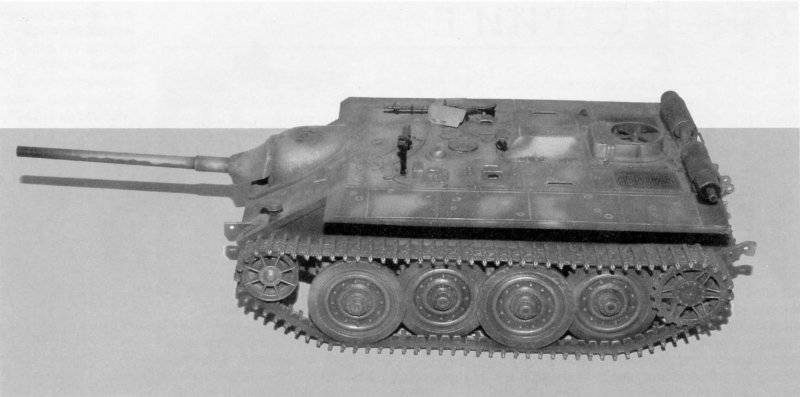
Something like this could look like a light tank destroyer E 10, armed with an 75-mm cannon Cancer 39 L / 48 (model made by S. Fedorov)
The machine was a tank destroyer armed with an 75-mm cannon Cancer 39 L / 48. However, this was not a definitively approved type of weapon, and the question of which artillery system to install on an 10 E remained open until the end of the war. The armored body of the vehicle was supposed to be assembled from armor plates installed at large angles of inclination: upper front 60 mm (at an angle 60 degrees), lower frontal - 30 mm (60 degrees), sides - 20 mm (10 degrees), fodder - 20 mm ( 15 and 33 degrees), roof and bottom - 10 mm.
Like all other machines in the E-series, the E 10 had a rear layout and transmission. For ease of maintenance, the rear fodder sheets were hinged, which greatly facilitated the maintenance and repair of the machine.
As the power plant was planned to use the engine Maybach HL 100 400 power l. with. In the future, it was planned to consider the possibility of installing on E 10 a different engine variant - 550-strong Maybach HL 101 with fuel injection directly into the cylinders. The use of such powerful engines on a relatively light machine (the estimated mass of E 10 was 15-16 tons, depending on the type of weapon selected for it) was the "German response" to the American tank destroyer M18 "Hel-Cat", which developed a speed of 17,7 tons on the highway to 90 km / h. This point was further specified by representatives of the Tank Armament Test Department (WaPruf 6) with Magirus engineers after the Wehrmacht met Helkat self-propelled guns during the battles in France. As a result, the estimated speed E of the 10 on the highway was more than 70 km / h.
In the chassis E 10 used four support roller diameter 1000 mm with rubber bands (on each side). Each of them was attached to the board separately, which facilitated maintenance and repair. Belleville springs (a spring consisting of cup washers) mounted in cylindrical housings were used as an elastic suspension element. This suspension system, developed by Dr. Lerom, became a peculiar "highlight" of all projects of the E series. When designing these machines, they decided to abandon the use of transverse torsion shafts above the bottom of the hull, as in "panthers" and "tigers". This made it possible not only to reduce the overall height of the vehicle, but also to provide an emergency hatch for the crew at the bottom of the tank, which the tankers repeatedly asked for. The rollers on the Е 10 were displaced one with another so that the track track ridge between them passed.

Side view of a medium tank destroyer £ 25 with a X-NUMX-mm cannon Cancer L / 75. However, the option of arming this machine has not been definitively determined.
However, the project E 10 had a difference from all other machines of the E-series - the suspension elements were equipped with an additional hydraulic drive, with which the self-propelled gun could change ground clearance (according to some sources, the 10 Е could “squat” on 200 mm). The use in the undercarriage of caterpillars with a width of 400 mm ensured a low specific pressure on the ground and, consequently, good permeability. And because of the length-to-width ratio that made up for the E 10 1,04, the car had to have good maneuverability. In terms of its dimensions (length with the 6,91 cannon m, length of the 5,35 hull m, width of the 2,86 meter, height of the 1,76 m) tank destroyer E 10 was comparable to the “Hetzer”.
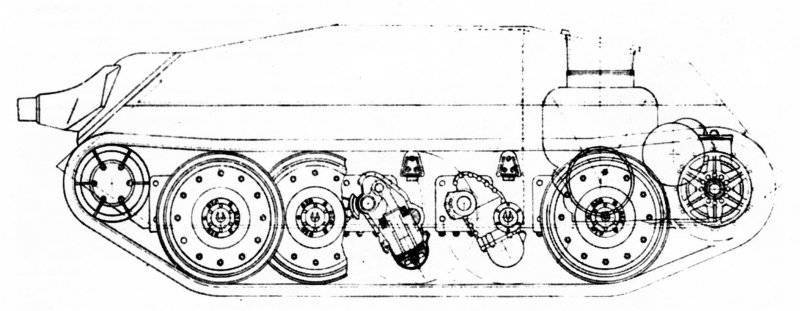
One of the conceptual designs of the tank destroyer E 25, on which the structure of the suspension elements is visible
After reviewing the project, the tank armament test department (WaPruf 6) concluded a contract with Magirus for the manufacture of three prototypes and their testing. However, no deadlines were set at the end of the work. Since Magirus was not engaged in armor production, armored hulls for E 10 were ordered from the Linke-Hofmann plant in Breslau, which were engaged in the manufacture of Hetzer-made armored hulls. By the time the city was surrounded by units of the Red Army in February 1945, they could not be completed.
PROJECT E 25
The contract for the development of chassis E 25 mass 25-30 tons spring 1943 year concluded with the company Argus Werke in the city of Karlsruhe. Here, the design of the machine was carried out under the direction of Dr. G. Klaue.
A preliminary draft of the machine, which was a tank destroyer, was submitted to the military in the autumn of 1944. He had a lot in common with E 10 (layout, general scheme), but was heavier. In the variant presented by Argus, the E 25 armament consisted of X-NUMX-mm cannon Cancer L / 75. However, this was not the final version, since the military considered other options, for example, an 70-mm caliber gun. But until the end of the war the choice of weapons was not finally determined.
As with E 10, the E 25 body was assembled from armor plates installed at large tilt angles: upper front 50 mm (at an angle 50 degrees), lower front 50 mm (55 degrees), side of the case 30 mm (upper part at an angle 52 degrees , lower vertical), feed 30 mm (at angles 40 and 50 degrees, respectively), roof and bottom 20 mm.
The machine had the following dimensions: body length 5,66 m, width 3,41 m, height 2,03 meter, ground clearance 0,51 m. The tank destroyer had a ratio of length to width 1,08, which was to ensure good maneuverability.
The undercarriage used the same track rollers as on the 10 E, but now there were five of them on one side. The mechanism for adjusting the height of the clearance on the E 25 was not provided. On the machine, it was planned to use wide 700-mm tracks, the design specific pressure was on the order of 0,65 kg / cm2.
On assignment E, the 25 should have had a power density of at least 20 l. with. per ton. Therefore, the same engine as the E 10 - 400-strong Maybach HL 100 was planned as its power plant, with a possible replacement with the more powerful Maybach HL 101 in 550 hp, the completion of which testing was expected at the end of March 1945. Due to delays in the development of these motors, the mounting of the 25 600-strong Argus air-cooled engine (it was planned to be placed across the hull) and the Otto aviation engine in 400 l were conducted. with. But these options were unsuccessful. As a result, they decided to install Maybach HL 230 in production.
At first, it was planned to use a manual gearbox on the E 25. But on the instructions of the Tank Armament Test Department (WaPruf 6), Zahnradfabrik in Friedrichshafen started the development of a semi-automatic gearbox for Е 1 from July 1944 on July 25. It was planned to make it to the beginning of 1945 of the year.
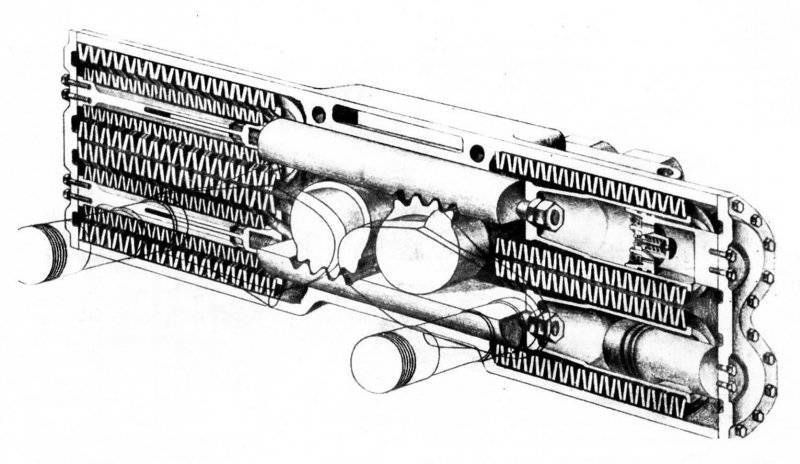
Diagram of the device of the elastic elements of the suspension of a tank destroyer E 25 with Belleville springs
In January, 1945, the tank development committee decided to manufacture three prototypes of the E 25 and conduct their tests. With their successful completion, this self-propelled gun could be considered as promising in the class of 25-ton tank destroyers. Three enclosures for E 25 began to be assembled at the Alkett factory in Berlin-Spandau, but could not be completed by the end of the war.
Projects E 50 and E 75
The development of the chassis for the E 50 and E 75 machines was assigned to Weserhutte in Bad Einhausen. Projects E 50 and E 75 were planned as so-called standard tanks. It was assumed that they would have the same engines, cooling system, fuel tanks, driving and steering wheels, tracks, track tension mechanism and a number of other nodes. Shells should have the same shape and the same overall dimensions. The internal volume of the E 50 was somewhat larger due to the use of thinner armor plates.
Thus, this project provided for the simultaneous manufacture of two types of tanks - the machines could be assembled on the same assembly line, using the same tools and fixtures.
As a power plant on the Е 50 and Е 75, it was planned to use the Maybach HL 233 P engine, which was planned to be put into mass production at the beginning of the 1945 of the year. It was a modernized version of the Maybach HL 230, which used other bearings, strengthened the design of the crankshaft and connecting rods. It was also up to 900 l. with. increased engine power due to the installation of a supercharger developed by Professor Kamm. But since the work on creating a supercharger was still far from completion, the option of installing a Maybach HL 50 engine with direct injection of fuel into the cylinders was considered on the E 75 / 234 engine. It was assumed that this engine will reach the power in 900 l. with. at 3000 rpm However, until the end of the war, the work on Maybach HL 234 was never completed.
The development of transmissions, brakes and control mechanisms was carried out in such a way that they could be installed in the hulls of both tanks without any special problems. Provided for the use of hydromechanical 8-speed gearbox with a multi-radius mechanism of rotation. The estimated speed for E 50 was 60 km / h, for E 75 — 40 km / h.
In addition, other power plant and transmission options were considered, such as the use of a Klockner-Humboldt-Deutz 8-cylinder diesel engine, a Voith hydromechanical gearbox and a Mech-Hydro mechanical company.
On the E 50 and E 75 machines it was planned to use the trolley suspension, each of which consisted of two rollers mounted on spring-loaded balancers. The rollers were displaced relative to each other so that the caterpillar track ridge passed between them. Belleville springs mounted in cylindrical casings arranged parallel to the bottom of the machine were used as elastic elements. In the E 50 suspension, three trolleys of skating rinks were used on board, and in E 75 - four each. In this case, E 50 tracks were planned to be used as transport tracks for the heavier E 75. At the end of the 1944, the plant Dortmund-Hoerder Huttenverein was supposed to test the elements of the suspension of the E 50 / 75 machines on the hull of the Royal Tiger tank, but this was not possible.
As for the armament of the E 50 and E 75, the development of the towers for these machines involved the company Krupp. However, until the end of the war, the question of what kind of weapons to install on these tanks was not finally resolved. So, the schemes of tanks E 50 and Е 75 with towers in many publications do not correspond to the actual state of affairs.
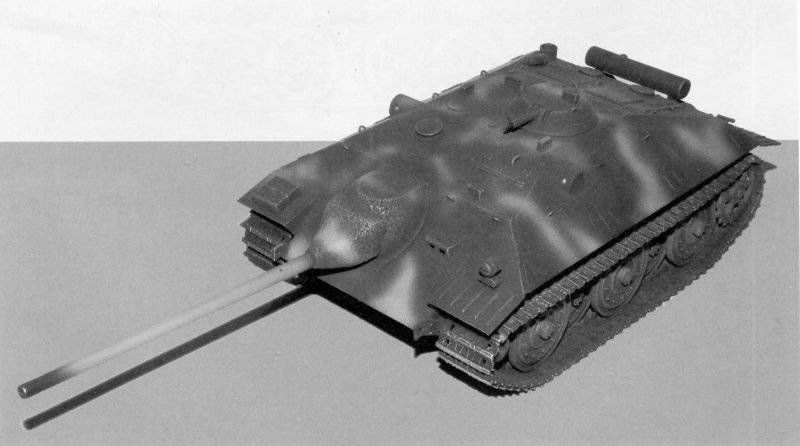
One of the possible choices of tank destroyer ЕNNUMX-С 25-mm cannon Cancer L / 75 and turret with a machine gun on the roof of the hull. This option is also found among the preliminary designs of the machine (model made by S. Fedorov)
It should be said that until the end of the war the design work on the E 50 and E 75 machines were very far from completion. It could not be a question not only of the production of prototypes, but even of the preparation of a complete set of drawings. Adler was engaged in the development of individual elements
tanks, such as suspension elements, transmissions and brakes, but it did not even make full-scale samples. Everything was limited to carrying out calculations, a number of tests and the construction of the necessary layouts and stands for this.
Project E 100
Strangely enough, the heaviest tank of the E series was closest to completion. Its development began by Adler in Frankfurt am Main in June 1943. The works were supervised by the technical director and chief designer of Adler K. Enshke.
The project was ready for the spring 1944 of the year. Unlike other E-series cars, the E 100 had a classic German tank layout with the engine in the rear and gearboxes in front. The body of the car was proposed to be made of armor of considerable thickness: the forehead of 200-150 mm (the angle of inclination of 30 and 45 degrees, respectively), the board of 120 mm, the feed 150 mm. In addition, the upper part of the board and the upper branch of the caterpillar were closed with 50-mm armored aprons, which were removed during the transport of the tank.
E 100 was equipped with a Maybach HL 230 engine, Maybach gearbox OLVAR OG 401216 and Henschel L 801 steering. In the future, it was planned to use a more powerful engine Maybach HL 234 and hydromechanical
Voith gearbox or mechanical company Mech-Hydro. According to Adler's calculations, with these units, the 140-tonne E 100 should have reached a speed of up to 40 km / h on the highway (which, in general, seems unlikely).
In the undercarriage, trimmed track rollers with a diameter of 900 mm were used, which had spiral springs as elastic elements. The caterpillar had a width of 1000 mm, in addition, it was planned to develop a narrower transport for the E 100.
The final decision on the arming of the tank E 100 was not made. There were two options - tools caliber 150 or 174-mm. The tower had a diameter weather in the light of 3060 mm, its development was entrusted to the company Krrr. Also considered the option of using the chassis E 100 as a base for self-propelled installation.
Despite the fact that in June 1944, Hitler ordered to stop all the experimental work on heavy tanks, the production of E 100 continued, albeit slowly. The prototype was built at Hausenbeck, near Paderborn. By the beginning of the 1945 of the year, the engine, transmission and undercarriage components are installed on the chassis. At the end of the war, the car was grabbed by the Allies.
Without a doubt, the E 100 cannot be considered as a promising version of a heavy tank. The car was so expensive and low-tech that the issue of its mass production was not considered at all. In addition, despite the thick armor and powerful weapons, the question of the high fighting qualities of the E 100 also raises serious doubts.
Most likely, the production of E 100 was carried out only "in peak" tank "Maus", designed by F. Porsche. It is known that E. Knipkamp, Chief Designer of the Tank Armaments Test Department (WaPruf 6), spoke very negatively about the Porsche tank. Perhaps, using his position, he “pushed through” the financing of the construction of E 100, trying to prove that this car would be better than the “Mouse”.
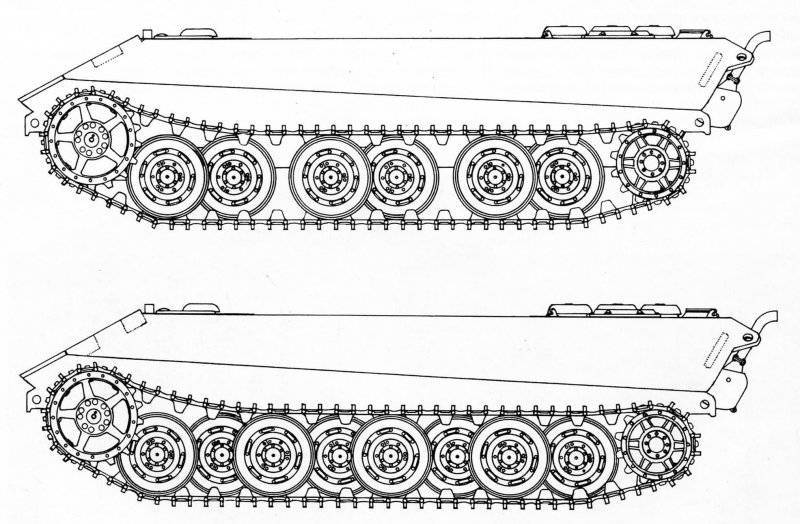
The chassis of heavy tanks of projects E 50 (above) and Е75 (below), which differed only in the thickness of the armor plates and the number of suspension trolleys
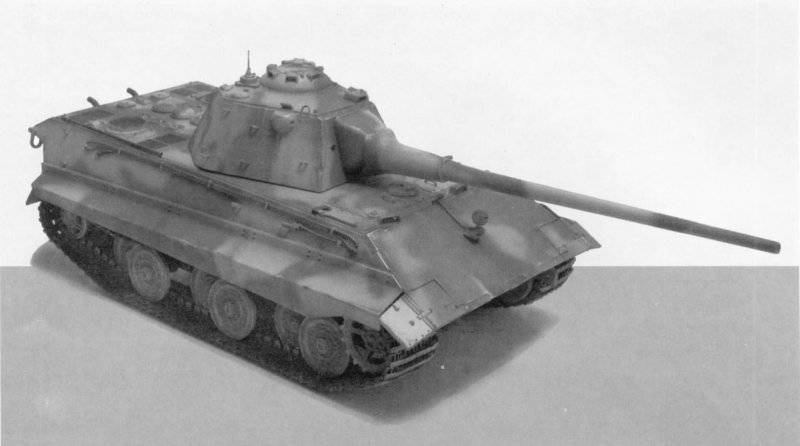
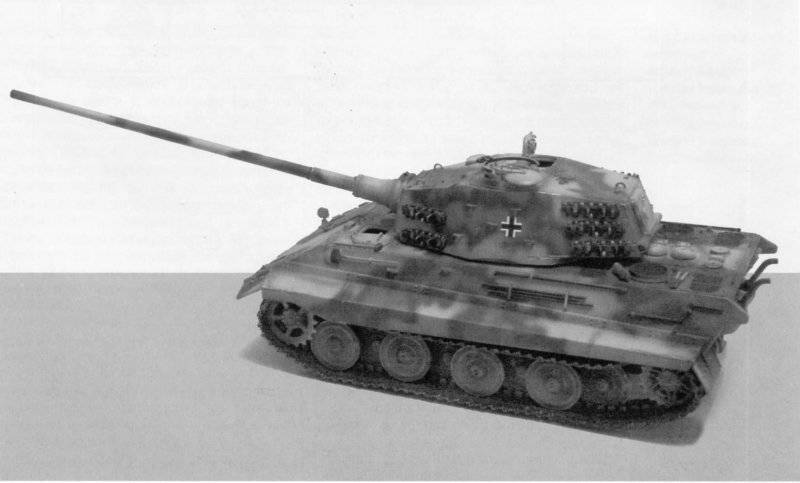
Possible weapons 88-mm cannon tanks E 50 (top) and E 75 (bottom). On the 50 E, a “narrow” tower was installed (according to the type developed for the Panther Ausf F), and on the 75, the tower was similar in design to the Royal Tiger tower (models made by S. Fedorov)
Thus, the projects of the E-series can hardly be considered as promising combat vehicles that could appear in service with the Panzerwa in the near future. Many employees involved in the E-series program were also aware of this. For example, construction adviser Avgustin, who worked in the tank weapon test department (WaPruf 6), said that “the development of tanks for this program was a purely research task, not having nothing to do with the serial production of tanks. These developments should not be taken seriously. ”
Thus, the E-series vehicles were never seriously considered projects that should be replaced by the Panther, Royal Tiger or self-propelled tanks that were in production. This was, so to speak, a research work on tank themes, and no one could say what would eventually come out of it. Thus, the E-series is in no way a kind of promising series of combat vehicles of various masses, which were planned to be adopted by the Panzervaffe. This information is not true and is a figment of the imagination of various authors. Proof of this, among other things, is the fact that the E projects were entrusted to companies very far from tank construction issues. If it were a question of developing a promising tank that was planned to be put into service, an order would certainly have been received by some large company that had experience in designing and manufacturing tanks, for example, Daimler-Benz, Krupp, MAN, Alkett or Henschel.
In addition, for the manufacture of prototypes of the E-series, their testing and the organization of mass production, if adopted, it took at least one and a half to two years. In addition to testing the engines, some of which existed only in single samples and were tested on the stands, and new gearboxes, the suspension system of the E-series cars raises serious questions.
Calculations have shown that the proposed option using Belleville springs will be easier to torsion and will withstand a considerable load. In addition, the new suspension was more convenient to maintain and repair - it was much easier to remove one roller or cart than to dismantle half of the rollers with a “chess” suspension.
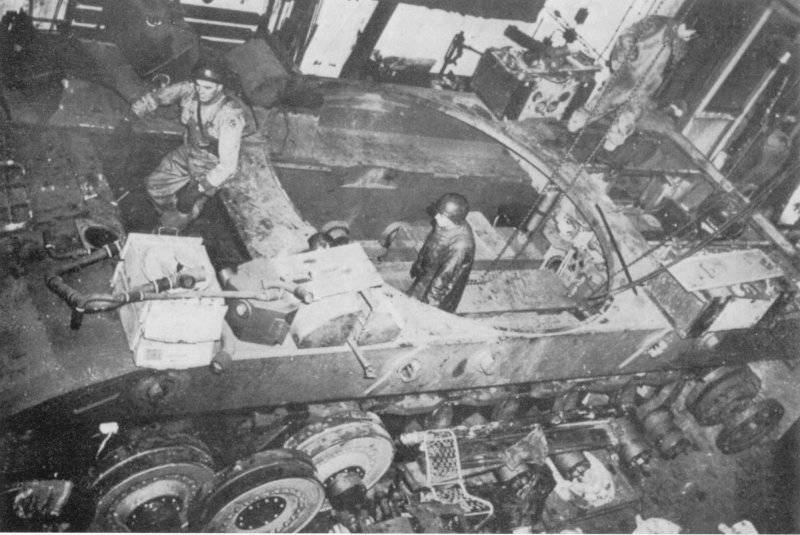
US military inspect the hull of the tank E 100, captured at an assembly plant in the city of Haustenbek (NW)
At the same time, the production of balancers and axes of rollers on the proposed variants of the E series required a lot of time for machining on turning and milling machines. In addition, it was necessary to pick up the material for the cup springs and work out the technology for their manufacture. As a result, it could turn out that, at a cost in production, the new suspension could be more expensive than the torsion bar, requiring the use of scarce materials and expensive machines.
Thus, if we summarize all of the above, then the E-series cars can be considered, in automotive terms, as “concept tanks”.

The hull of the tank E 100 with installed support rollers, left view. The hull has already been removed from the assembly shop (NW)
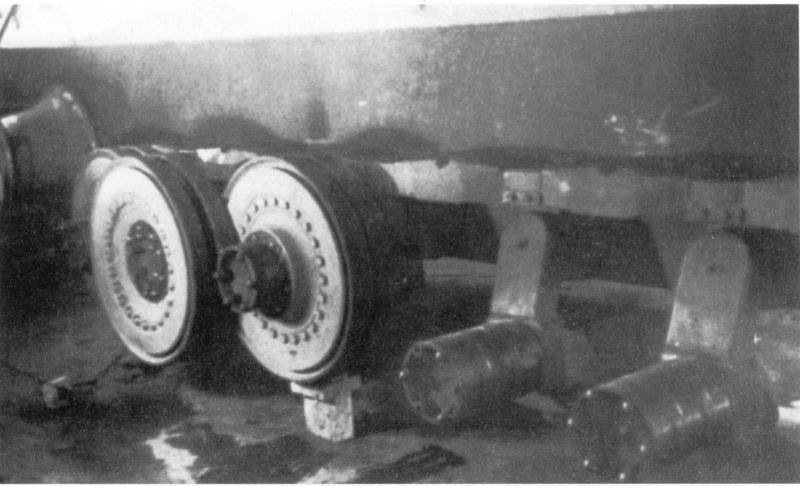
Suspension elements of the super heavy tank E 100: well-supported rollers and balancers (NW) are clearly visible
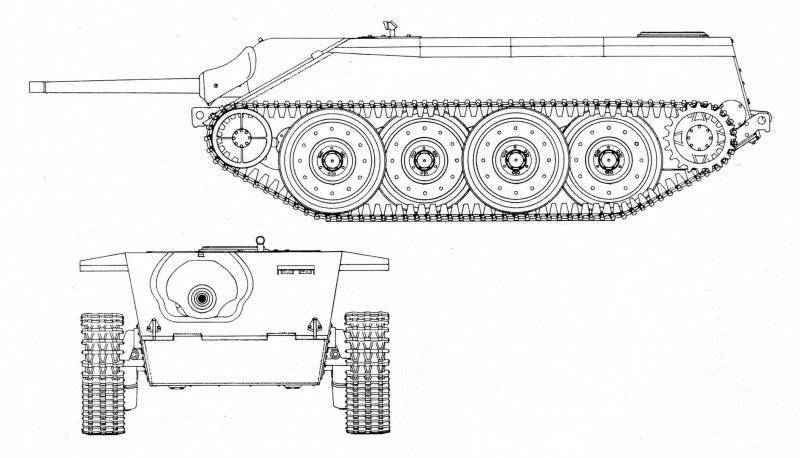
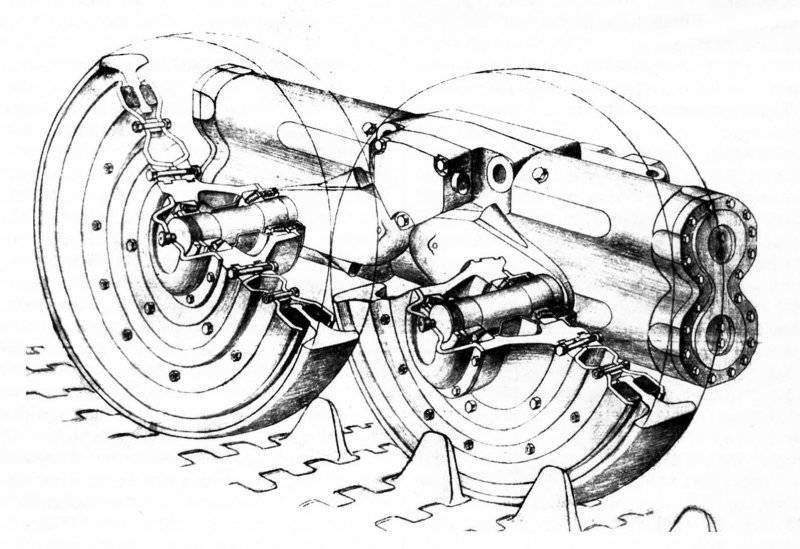
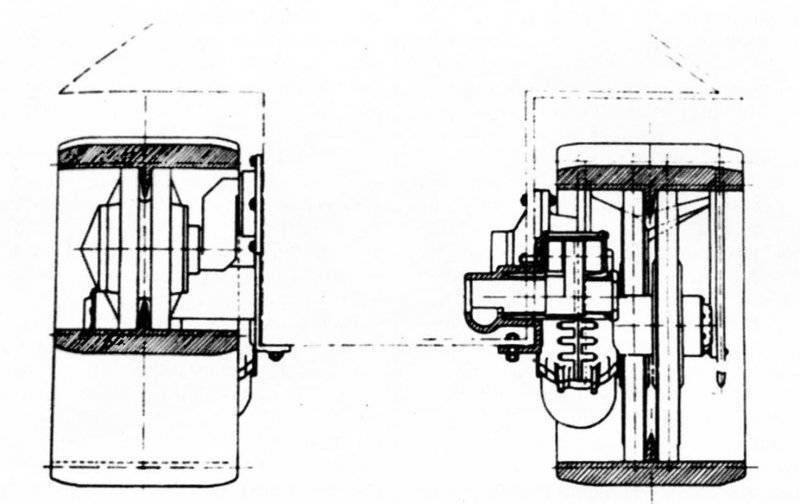
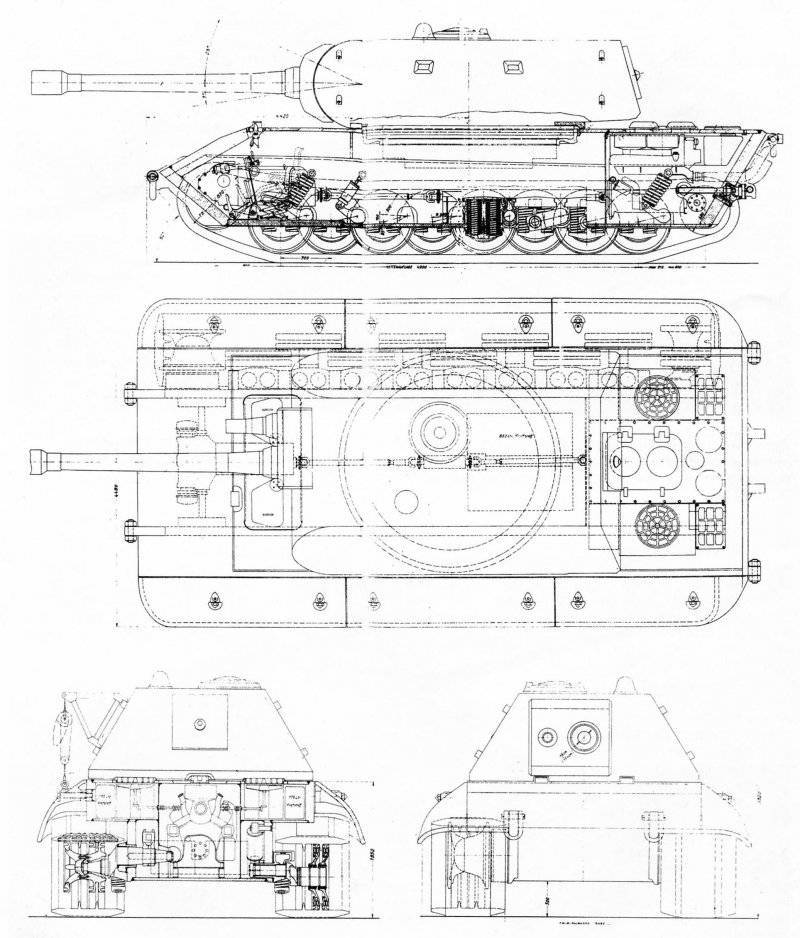
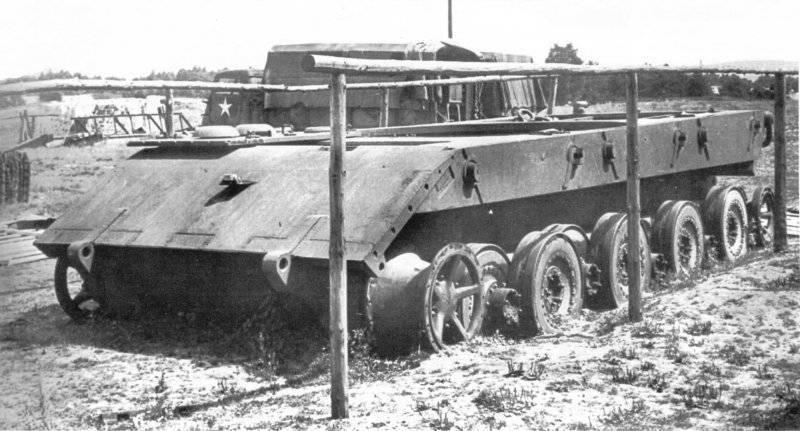
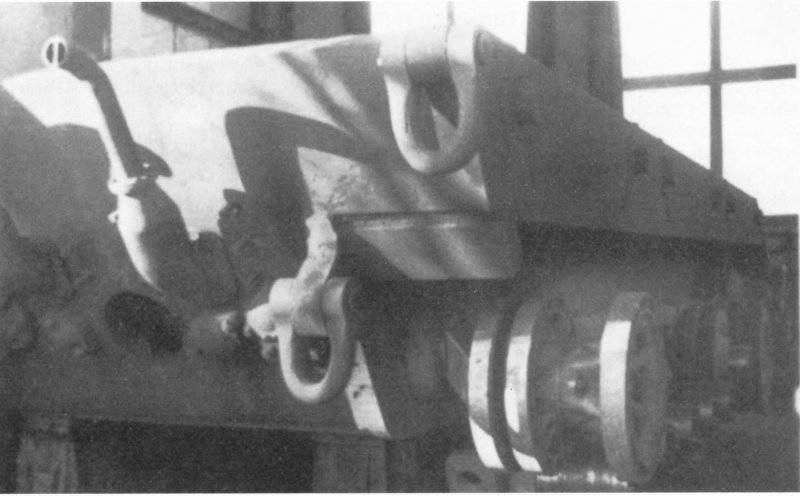
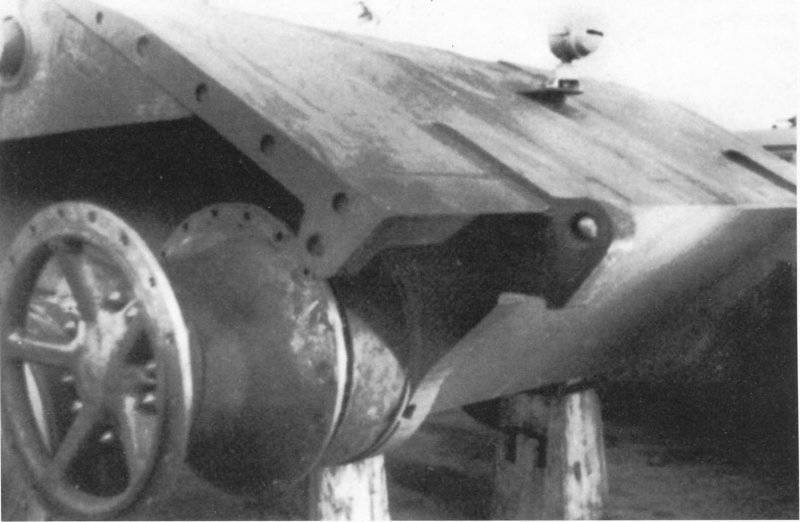
Information